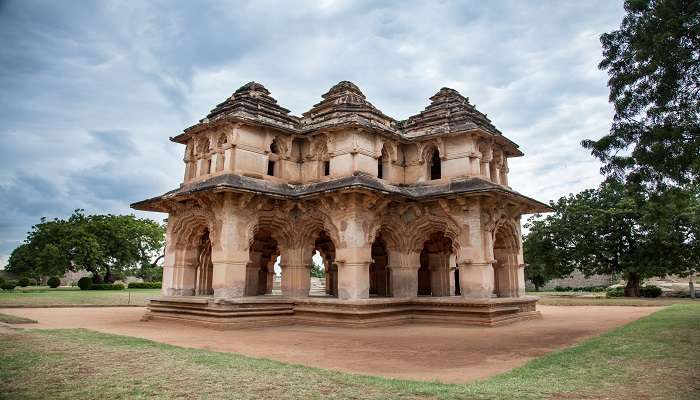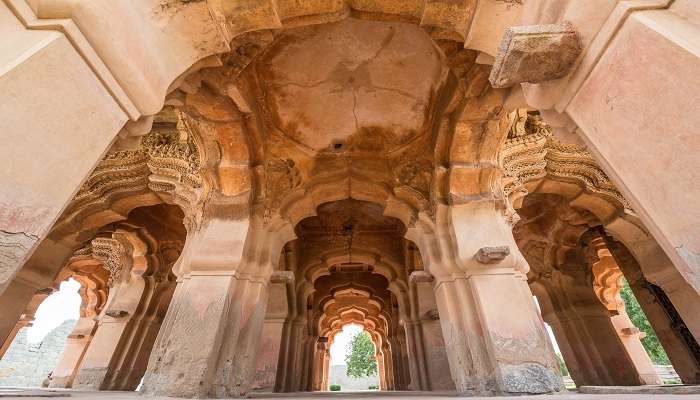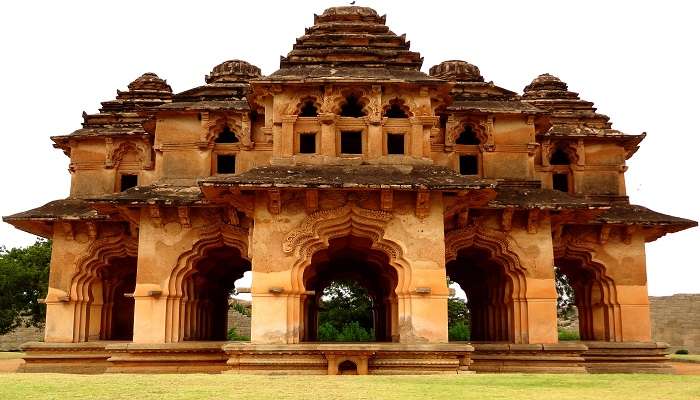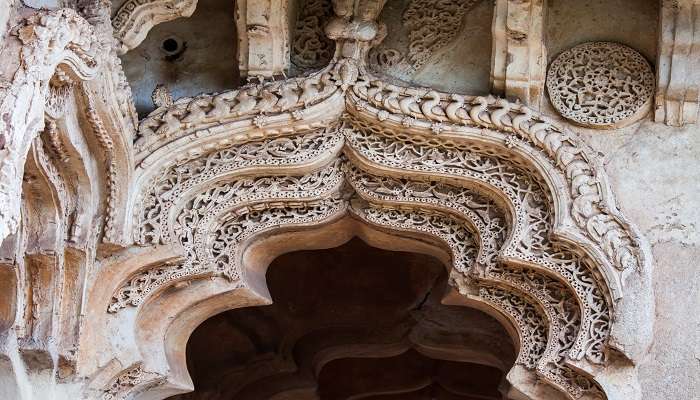Unveil The Beauty Of Lotus Mahal In Karnataka On Your Hampi Trip 2025

A tour to Hampi is complete with visiting the Lotus Mahal. It is one of the fine architectural palaces uniquely identified by its lotus-like structure. This glorious building is within the Zenana Enclosure, a segregated area that the royal women of the Vijayanagara Dynasty used. The Lotus Mahal is otherwise called the Kamal Mahal or Chitragani Mahal. Its remarkable and unmistakable design is the main highlight of the palace. It is one of only a few astonishing buildings in Hampi that had not been damaged or destroyed amid the attack on the city.
About Lotus Mahal

Lotus Mahal is an essential monument in Hampi. Lotus Mahal is a virtual air-conditioned residence built for one of the two wives of Vijayanagara ruler Krishnadevaraya. The Mahal had a water tank on the top and water pipes through the beams and columns, facilitating water flow through the structure and keeping it cool even in hot summer (Summer in Ballari district can get extremely hot). Lotus Mahal, also called Chitrangi Mahal, features a lotus-like design and is mainly intact over the centuries. Lotus Palace has three stories featuring an open design with long corridors supported by 24 pillars and no walls. The pillars and arches of Lotus Palace have intricate carvings. A mix of Indian and Islamic design styles can be seen in Lotus Mahal. A couple of watch towers can be seen far from the Lotus Mahal. The elephant enclosure is located a short distance away. Besides being an engineering marvel, Lotus Palace is quite photogenic as well.
Must Read: Hotels In Hampi For Family
Architecture Of The Lotus Mahal

The Lotus Temple in Hampi is a splendid example of a harmonious architectural combination of Indian and Islamic (or Saracenic) architectural styles. Other than this, the overall plan of the palace is exceptional, often praised for the ingenuity of the Vijayanagar artisans. With cusped arches and intricate decorations, the ground floor has a spectator section that was once used by the royals for the congregation. An inclined eave also surrounds the tower. The place gets its name from archways resembling a lotus’s petals. This gives the entire structure the shape of a half-open lotus bud. Also, the dome in the centre is carved in the shape of a lotus bud, while towers are pyramidal.
One of the most prominent carvings is that of Makara Torana, which is a significant sea creature in Hindu mythology. It is also considered to be the vehicle of Goddess Ganga. The pipeline work spotted between the arches and sides of the roof is why Kamal Mahal in Hampi was the queen’s place to relax. This was used to cool the palace and maintain its temperature. Also, to ensure the safety of the queen and other royal women, three watchtowers were used to keep an eye on intruders.
History Of Lotus Mahal

The Lotus Mahal was a part of the Zenana enclosure, where royal families of the Vijayanagara Empire resided. Lotus Mahal was designed as a palace for royal ladies of those times to mingle around and enjoy recreational activities. The Mahal also served as a meeting point for the king and his ministers. This place is also referred to as a council chamber in the maps. It is said that the Queen of Krishna Deva Raya used to spend most of the time seeking pleasure and peace in the palace. The palace also served as a meeting point for the king and his ministers. Kamal Mahal is also referred to as a council chamber in the maps found in the 18th century. Kamal Mahal and Chitrangini Mahal are the other names by which it was known earlier. Several musical concerts and other recreational activities were held at this place.
Suggested Read: Historical Places In Karnataka
How To Reach

Lotus Mahal is located in Hampi. Hampi, the ancient capital of the Vijayanagara Empire and a UNESCO World Heritage Site is a must-visit destination for history buffs and nature lovers alike. Here’s how you can reach this architectural marvel in Karnataka, India.
By Air:
The nearest airport to Hampi is Belgaum Airport, about 190 km away. However, consider flying to Bangalore International Airport (330 km) or Goa International Airport (350 km) for better connectivity. You can hire a taxi from these airports or take a bus to Hampi. While not the closest option, flying offers convenience for international travellers or those from distant parts of India.
By Rail:
The nearest railway station to Hampi is Hospet Junction (Hospet), just 13 km away. It’s well-connected to major cities like Bangalore, Goa, and Hyderabad. Overnight trains from Bangalore are prevalent. From Hospet, you can easily reach Hampi by auto-rickshaw, taxi, or local bus. The train journey offers a glimpse of the changing landscape as you approach the historical region.
By Road:
Driving to Hampi can be an adventure, allowing you to explore the countryside at your own pace. The roads are generally in good condition, making it a comfortable journey. For those who prefer public transport, several state-run and private buses connect Hampi to significant cities. Overnight sleeper buses from Bangalore, Hyderabad, and Goa are standard and comfortable options.
Further Read: Hill Stations In Karnataka
Now that you have a list of things to keep in mind for your next vacation to see the beautiful Lotus Mahal make sure you plan your trip to Karnataka to these fabulous spots for the experience of a lifetime. Don’t miss out on these opportunities and book your tickets now!
For our editorial codes of conduct and copyright disclaimer, please click here.
Cover Image Credit: Shivajidesai29 for wikimedia commons
Frequently Asked Questions About Lotus Mahal
Where is Lotus Mahal in Hampi?
Lotus Mahal is a stunning architectural marvel in the Zenana Enclosure of Hampi. It's a two-story pavilion-like structure that gets its name from its lotus-like appearance when viewed from above. The building is believed to have served as a council chamber for royal women.
When was the Lotus Mahal built?
Lotus Mahal was constructed during the Vijayanagara Empire, likely in the 16th century. It's a prime example of Indo-Islamic architecture, blending Hindu and Islamic styles.
What's unique about Lotus Mahal's architecture?
The structure features ornate arches, balconies, and intricate carvings. Its domed roof resembles lotus petals, and the building has a symmetrical design. The structure also had an advanced cooling system, with pipes circling water through the walls.
Can visitors enter the Lotus Mahal?
While visitors can't enter the structure, they can explore the area around it and admire its exterior architecture up close.
What's the best time to visit the Lotus Mahal?
The best time to visit is from October to February when the weather is cooler. Early morning or late afternoon visits offer the best lighting for photography. The site is open from sunrise to sunset, and it's included in the general Hampi entry ticket.
People Also Read:
Hawa Mahal Taj Mahal Sundar Mahal

As a Travel Content Writer, I live to conquer the world of globetrotting with words. With my unquenchable thirst for storytelling, I believe that my words will inspire you to travel around the world’s breathtaking landscapes. As for me, I am an unapologetic selenophile, who loves to wander around in a starry night!











